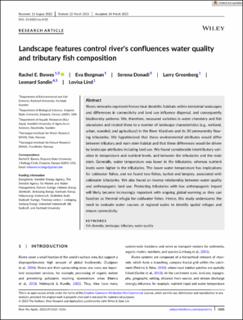Landscape features control river's confluences water quality and tributary fish composition
| dc.contributor.author | Bowes, Rachel | |
| dc.contributor.author | Bergman, Eva | |
| dc.contributor.author | Donadi, Serena | |
| dc.contributor.author | Greenberg, Larry | |
| dc.contributor.author | Sandin, Leonard | |
| dc.contributor.author | Lind, Lovisa | |
| dc.date.accessioned | 2023-09-21T13:37:40Z | |
| dc.date.available | 2023-09-21T13:37:40Z | |
| dc.date.created | 2023-04-18T10:40:11Z | |
| dc.date.issued | 2023 | |
| dc.identifier.citation | Rivers Research and Applications. 2023, 39 (6), 1025-1036. | en_US |
| dc.identifier.issn | 1535-1459 | |
| dc.identifier.uri | https://hdl.handle.net/11250/3091124 | |
| dc.description.abstract | Rivers networks represent hierarchical dendritic habitats within terrestrial landscapes and differences in connectivity and land use influence dispersal, and consequently biodiversity patterns. We, therefore, measured variation in water chemistry and fish abundance and related these to a number of landscape characteristics (e.g., wetland, urban, wooded, and agricultural) in the River Klarälven and its 30 permanently flowing tributaries. We hypothesized that these environmental attributes would differ between tributary and main stem habitat and that these differences would be driven by landscape attributes including land use. We found considerable intertributary variation in temperature and nutrient levels, and between the tributaries and the main stem. Generally, water temperature was lower in the tributaries, whereas nutrient levels were higher in the tributaries. The lower water temperature has implications for coldwater fishes, and we found two fishes, burbot and lamprey, associated with coldwater tributaries. We also found an inverse relationship between water quality and anthropogenic land use. Protecting tributaries with low anthropogenic impact will likely become increasingly important with ongoing global warming as they can function as thermal refugia for coldwater fishes. Hence, this study underscores the need to evaluate water courses at regional scales to identify spatial refuges and ensure connectivity. | en_US |
| dc.language.iso | eng | en_US |
| dc.publisher | Wiley | en_US |
| dc.rights | Navngivelse-Ikkekommersiell 4.0 Internasjonal | * |
| dc.rights.uri | http://creativecommons.org/licenses/by-nc/4.0/deed.no | * |
| dc.title | Landscape features control river's confluences water quality and tributary fish composition | en_US |
| dc.type | Peer reviewed | en_US |
| dc.type | Journal article | en_US |
| dc.description.version | publishedVersion | en_US |
| dc.rights.holder | © 2023 The Authors | en_US |
| dc.source.pagenumber | 1025-1036 | en_US |
| dc.source.volume | 39 | en_US |
| dc.source.journal | Rivers Research and Applications: an international journal devoted to river research and management | en_US |
| dc.source.issue | 6 | en_US |
| dc.identifier.doi | 10.1002/rra.4133 | |
| dc.identifier.cristin | 2141531 | |
| cristin.ispublished | true | |
| cristin.fulltext | original | |
| cristin.qualitycode | 1 |
Tilhørende fil(er)
Denne innførselen finnes i følgende samling(er)
-
Publikasjoner fra Cristin - NIVA [2160]
-
Scientific publications [1172]

